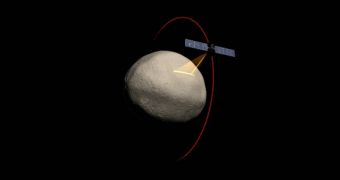The Dawn space probe is scheduled to soon enter orbit around the largest asteroid in the solar system, Vesta. The massive space object is already within reach, and instruments aboard the probe can already see it as a very distant object.
At this point, the massive asteroid is located about 143 million miles from Earth, experts in charge of managing the mission say. Dawn launched towards it back in September 2007, and has spent the past few years chasing the object through the solar system.
Vesta orbits the Sun inside the Inner Asteroid Belt, an area containing massive volumes of space rocks and debris. The IAB is located between the orbits of Mars and Jupiter, and is also home to the dwarf planet Ceres.
The asteroid completes a full orbit around the star every 3.6 years. It is shaped like a pumpkin, with an average diameter of around 330 miles. Planetary scientists say that it appeared very on in the history of the solar system, some 3 to 10 million years after the Sun formed.
For all intents and purposes, Vesta is a protoplanet, an object that – given other conditions – would have developed into a fully-fledged planet. It has the same internal structure as Earth, Venus, Mars, and Mercury, experts say.
However, the object's gravitational pull is way weaker than ours is, which means that Vesta has a hard time holding on to its atmosphere. Experts are understandably very interested in learning how it formed, what stopped its development, and why.
Dawn will start searching for answer to these questions next month, when it arrives at the asteroid ahead of schedule. It will remain in orbit for around a years, during which it will occupy two orbits, one at 400 miles, and the other at 125 miles above the surface.
“There are many mysteries about Vesta. One of them is why Vesta is so bright. The Earth reflects a lot of sunlight – about 40 percent – because it has clouds and snow on the surface, while the Moon reflects only about 10 percent of the light from the Sun back,” says Christopher T. Russell.
“Vesta is more like the Earth. Why? What on its surface is causing all that sunlight to be reflected? We'll find out,” adds the expert, who is the principal investigator of the new mission.
Russell also holds an appointment as a professor of geophysics and space physics at the University of California in Los Angeles (UCLA). “We often refer to Vesta as the smallest terrestrial planet,” he says.
“We expect to see a lot of craters. We know there is an enormous crater at the south pole that we can see with the Hubble Space Telescope. That crater, some 280 miles across, has released material into the asteroid belt,” Russel explains.
“Small bits of Vesta are floating around and make their way all the way to the orbit of the Earth and fall in our atmosphere. About one in every 20 meteorites that falls on the surface of the Earth comes from Vesta. That has enabled us to learn a lot about Vesta before we even get there,” he adds.
The expert has been planning this mission since 1992. “It's been a long trip. Finally, the moment of truth is about to arrive,” Russell concludes.

 14 DAY TRIAL //
14 DAY TRIAL //